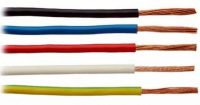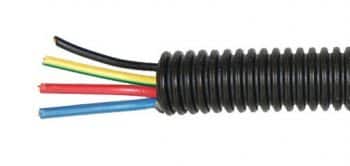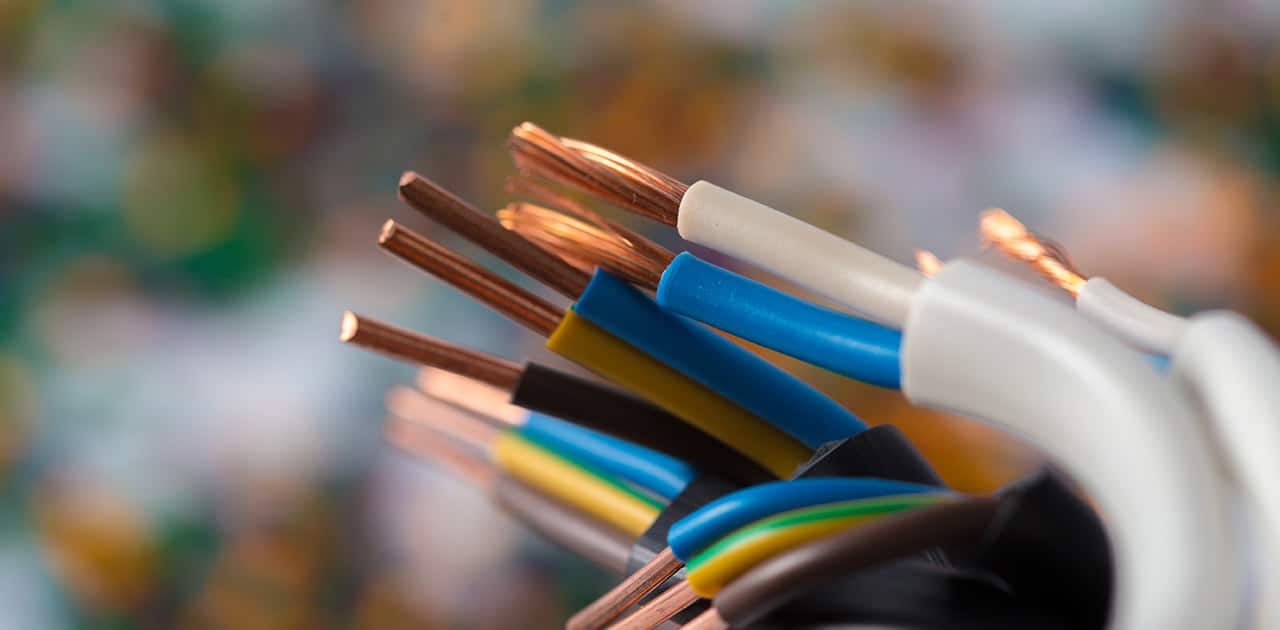Table of Contents
Electrical wires and cables – what’s the difference?
To carry out your electrical installations safely, it’s important to know how to distinguish between a wire and an electrical cable. A look at some basic concepts, including the definition and characteristics of electrical wires and cables.
Electric wire: Definition
An electrical wire is an electrotechnical component used to transport electricity in order to transmit energy or information. It consists of a conductive material surrounded by an insulating jacket. The conductive element inside an electric wire is called the “core”. Single-stranded (rigid) or multi-stranded (flexible) depending on its cross-section and purpose, the core can be made of copper, nickel-plated copper or nickel. The insulating jacket is usually made of PVC and varies in colour depending on the purpose of the wire. 
H07VU, H07VR and H07VK conductors are the most common. Here are the characteristics of these wires and their correspondence: Example: H07 VU 1.5 mm².
- H or U: The first letter is a national or international landmark;
- 07: for 700 V, maximum voltage supported by the wire ;
- V: PVC insulating sheath (R for PRC) ;
- U: copper core; U and R indicate rigid cores, K a flexible core;
- 1.5 mm2: wire cross-section.
Electrical cable: Definition
An electrical cable is made up of several wires joined together in a single or double protective sheath. It can have 2, 3, 4 or 5 wires. The number of wires in a cable depends on its diameter and its use. Electrical cables can be used to carry electric current (heavy current) or to transmit data such as telephone, computer or TV signals (light current). The names of the cables are the same as those of the wires, followed by the following information:
- The number of threads contained
- Wire cross-section
- A letter code: G if one of the wires is earthed, X otherwise.

For example: U1000 R2V 3G 1.5 mm².
- U : Rigid solid core ;
- 1000: permissible voltage up to 1000 volts ;
- R: rigid multi-strand ;
- V: polyvinyl chloride (PVC) sheath. Preceded by the number 2 (2V), the sheath is double insulated.
The cable contains 3 wires with a cross-section of 1.5mm2 including an earth wire. For a cable without earth wire, the name will be U1000 R2V 3X 1.5mm2.
What are the different types of electrical wire and cable ?
Each cable or conductor is designated by a code made up of letters and numbers that specify the characteristics of the material. The cable sheath shows the code in question.
Electrical wires and installation cables
Electrical wires and installation cables are used for fixed installations and for wiring the electrical switchboard. A distinction is made between :
- H07VU, H07VR, H07VK: These are the most commonly used conductors. They are intended for domestic installations, homes and offices. As soon as the cross-section exceeds 4 mm², we no longer speak of H07VU wire but of H07VR wire. The H07VU and H07VR wires are rigid, whereas the H07VK wire is flexible.
- U1000 R2V cable: This cable is recommended by EDF for connecting the electricity meter. It can also be used to wire electrical sockets or lights located outdoors.
- The remote-report cable: This connects the EDF box to your home. It transmits consumption data and enables the technician to read the meter from outside your home.
- Earthing cable: This copper cable is used to earth the electrical installation.
- TBT: This is used for mounting halogen spotlights on cable: the core is made of silver-plated copper and protected by a 6 mm² transparent insulating sheath.
Domestic cables
Domestic cables are flexible and supply power to mobile or semi-mobile devices. They are also used to design extension leads. A distinction is made between :
- H03VVH2F: This 2-conductor cable can be used to power lights and small equipment such as coffee makers, toasters and irons.
- H03 VVF/H05 VVF: The H03VVF is used to power household appliances and office equipment. The H05VVF is suitable for powering household appliances such as washing machines and refrigerators.
- The H03 RTF: This can be used to power a chandelier or a light fitting. It comes in a range of colours and the fabric is decorative.
- H07 RNF: Resistant to moisture and impact thanks to its neoprene sheath, it is suitable for extension leads and reels.
Multimedia wires and cables
Multimedia wires and cables are used to set up fixed installations and to wire the electrical distribution board. The cables used are as follows:
- Telephone cable: This is made up of one or more wires depending on its use: telephone, intercom, alarms or bell.
- Hi-Fi cable: This is used to power all audio equipment (including vehicles).
- Network cable: Double-shielded DTT cables are used to receive digital television. RCA cables transmit audio and video signals, while RJ45 cables are suitable for communication and computing.
What are the colour codes for electrical wires?
Colour coding is essential in electricity to ensure that your installation complies with standards and to prevent hazards. Red, green, blue or yellow wires, here are the corresponding colour standards for each electrical cable:
Couleur | Câble | Fonction |
Rouge / marron / noir / violet / orange / gris | PHASE | Fil par lequel le courant "arrive" |
Bleu | NEUTRE | Fil référence de tension |
Jaune et vert | TERRE | Fil de mise à la terre |
Good to know: Not all countries share the same colour codes. Similarly, in France, older installations can be built to earlier standards. Phase tester screwdrivers will show you the purpose of each wire.
How do I choose the right section of electrical wire?
The 3 essential criteria for choosing your cable
When fitting out your electrical installation, there are 3 main criteria to bear in mind:
- The cross-section, which depends on the power of the devices to be connected to the circuit.
- The length of the circuit, which will also determine the cross-section (the longer the wire, the larger the cross-section).
- The nature of the circuit, which supplies power to sockets, heating or lighting.
Standards and regulations
Standard NF C 15-100 defines a conductor cross-section (in mm²) for each use, adapted to the current (in amperes) that the circuit must withstand. The higher the current, the larger the cross-section. On a day-to-day basis, the voltage is 230 V. Here is a table summarising the appropriate wire cross-section according to the current or power required:
Puissance raccordée | Intensité | Section recommandée | Usage (exemple) |
2 300 W | 10 A | 1,5 mm² | Eclairage |
3 680 W | 16 A | 2,5 mm² | Prise de courant (électroménager) |
5 750 W | 25 A | 4 mm² | Circuits de puissance (cuisinière électrique, chauffage) |
7 360 W | 32 A | 6 mm² | Circuits de puissance |
9 200 W | 40 A | 10 mm² | Liaison compteur |
Pre-wired ICTA ducts: an optimised solution for your electrical installations
ICTA sheaths are plastic tubes used to bundle electrical wires for high-current connections, or computer cables for low-current transmission. This corrugated sheath consists of an insulating plastic tube that protects the conductors inside. ICTA sheaths can be fitted with a wire-pulling system, or pre-wired. 
